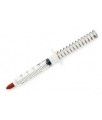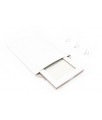A Proof of Principle
The Demonstration Cell kit is designed for people who would like to make bigger Dye Solar Cells. With an active area of 81 cm2, this type of solar cell can easily power a small electric load, and will run nicely in diffuse light such as in offices.
Simple or Elaborate
The simplest way for making a demonstration cell consists of dying the titania anode with a natural dye. The cathode can be prepared from a conductive glass and a pencil (carbon source). These electrodes are then put together using binder clips, leading to an open-air cell. The Demonstration Cell Kit Basic includes these electrodes in one package.
Alternatively, the demonstration cell can be assembled in a sealed configuration for durability. Use the gasket to seal the electrodes together, while electrolyte is added through holes in the cathode. The Advanced variant of the Demonstration Kit includes all the required parts.
In this configuration, we recommend using a ruthenium dye, such as Ruthenizer 535-bisTBA for the sensitization of the titania electrode, and a robust iodide electrolyte like Iodolyte Z-50.
Basic Kit
The Demonstration Kit is available in a Basic configuration where the solar cell is open, making it easier to assemble. It may last only for a few hours, but long enough for the purpose of training courses.
Included in the Demonstration Cell Kit, Basic:
- Titania Electrode, 1 pc. (73101)
- Bare Electrode, not drilled, 1 pc. (73602)
Advanced Kit
Alternatively, the Demonstration Cell Kit is proposed in an Advanced configuration where the electrodes are sealed together for longer durability.
Included in the Demonstration Cell Kit, Advanced:
- Titania Electrode, 1 pc. (73101)
- Platinum Electrode, drilled, 1 pc. (73201)
- Gaskets, 2 pcs. (73301)
- Sealings, 5 pcs. (73401)
- Caps, 5 pcs. (73501)
Combine this kit with our chemicals to obtain all the ingredients for making pristine Dye Solar Cells!
Spare Parts
Each part of the Demonstration Cell Kit can be purchased separately.
- Electrode size :
- 100 x 100 mm
- Active area :
- 90 x 90 mm
- Typical use :
- demonstration purpose, proof of concept
Demonstration Cell Titania Electrode
- Made from TCO22-7 FTO coated glass
- Prepared by screen-printing for a homogenous surface using our Ti-Nanoxide pastes
- Dimensions: L:100 x W:100 x H:2 mm
- Active area: 90 x 90 mm
- 1 pc. included
Demonstration Cell Platinum Electrode
- Made from TCO22-7 FTO coated glass
- Prepared by screen-printing for a homogenous surface using our Platisol T/SP precursor
- Drilled for electrolyte filling
- Dimensions: L:100 x W:100 x H:2 mm
- Active area: 100 x 100 mm
- 1 pc. included (Advanced Kit)
Demonstration Cell Bare Electrode
- Made from TCO22-7 FTO coated glass
- Ready to host a deposited layer
- Dimensions: L:100 x W:100 x H:2 mm
- 1 pc. included (Basic Kit)
Demonstration Cell Gaskets
- Made from Meltonix 1170-60 sealing film
- Matches the shape of the active area of Demonstration Cell Titania Electrodes
- Dimensions: 96 x 96 mm (outer), 90 x 90 mm (inner)
- 2 pcs. included
Demonstration Cell Sealings
- Made from Meltonix 1170-60 sealing film
- Used in combination with a Demonstration Cell Cap for sealing filling holes
- Dimensions: 8 x 8 mm
- 5 pcs. included
Demonstration Cell Caps
- Thin glass lid
- Used in combination with a Demonstration Cell Sealing for sealing filling holes
- Dimensions: diameter 6 mm
- 5 pcs. included




 Swiss Made - Solaronix is a Licensee of EPFL
Swiss Made - Solaronix is a Licensee of EPFL 
